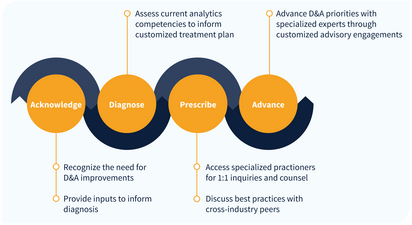Client Inquiry:
We're just getting started with the idea of implementing a new analytics operating model. As a centralized team, we’ve struggled to meet business demand—and in our absence, partner segments have started building their own analytics capabilities. Now we’re facing fragmentation across tools, roles, and delivery models. We need to understand what a federated model is actually designed to solve, how to structure it, and how to manage the transition without losing alignment, trust, or speed.
Expert Takeaways:
1. What a Good Operating Model Solves For
When companies adopt a new operating model for analytics, it’s often triggered by chaos: too much demand, too little alignment, and too many teams doing their own thing. But a federated model isn’t just about structure—it’s about providing clarity at scale.
- A good operating model answers foundational questions: How do we engage the business? How does work flow across teams? How do we make decisions and deliver at speed?
- Organizational structure is about reporting lines. Operating models are about how work gets done. Think of it as the operating system that runs across your org chart.
- In the absence of clear direction, teams invent their own. That leads to divergent tooling, titles, and definitions—and undermines scalability.
- To start, create a plainspoken problem statement. If you can’t explain it to your neighbor in one paragraph, it’s not ready for primetime.
- Simple language creates alignment. Drop the jargon. Start with what’s broken, and why now is the right moment to fix it.
2. Foundations for a Federated Model
Federation doesn’t mean “everyone does their own thing.” It means local teams can move quickly—within a shared framework.
- Establish a central hub to provide standards, architecture, governance, and shared services. But lead with influence, not authority.
- Product managers and program leads are critical. They connect the business to delivery teams, coordinate priorities, and manage intake.
- Intake doesn’t have to be a bureaucracy. Start small—cadenced office hours, quarterly PI-style planning, and lightweight prioritization models work well.
- Introduce simple phase gates. These aren’t roadblocks—they’re quick checks documented in Confluence or shared workspaces that keep teams aligned without slowing them down.
- Transparency builds trust. Make every review visible. Give partner teams a window into decision-making, not just a list of deliverables.
3. Rebuilding Trust and Momentum
If decentralization is already underway, the goal isn’t to reel it back in. It’s to reframe the relationship.
- Acknowledge the situation honestly. If central said “no” too often, partners were right to take action. Own it and move forward together.
- Don’t start with tools or structure. Start with outcomes: What is the business trying to achieve, and how can analytics help?
- Co-design shared priorities. Then ask: how do we work better together to deliver on those? That’s the moment to begin rethinking structure.
- Let decentralized teams own local solutions—but establish shared standards and light-touch review processes to stay aligned.
- There’s no one-size-fits-all in federation. Tailor the model based on the problem being solved and the readiness of each group.
4. Change Management Is the Work
Transitioning to a federated model isn’t just a technical shift. It’s a cultural one—and that takes time.
- Start by rebuilding relationships. If teams sprang up in isolation, they likely don’t trust the center. That trust has to be earned back.
- Organize around shared goals. Help teams see how their work and yours connect to broader business outcomes.
- Design transition moments deliberately. Consider short-term experiments that let decentralized teams prove ownership—while contributing to enterprise goals.
- Recognize this will take time. It’s not a six-week reorg. A 12–18 month arc is realistic for real operating model change, especially when trust has eroded.
- Help leadership understand that, too. Bring in external examples or frameworks to show that progress requires patience—and partnership.
Expert Network
IIA provides guided access to our network of over 150 analytics thought leaders, practitioners, executives, data scientists, data engineers with curated, facilitated 1-on-1 interactions.
- Tailored support to address YOUR specific initiatives, projects and problems
- High-touch onboarding to curate 1-on-1 access to most relevant experts
- On-demand inquiry support
- Plan validation and ongoing guidance to advance analytics priority outcomes
- Monthly roundtables facilitated by IIA experts on the latest analytics trends and developments
